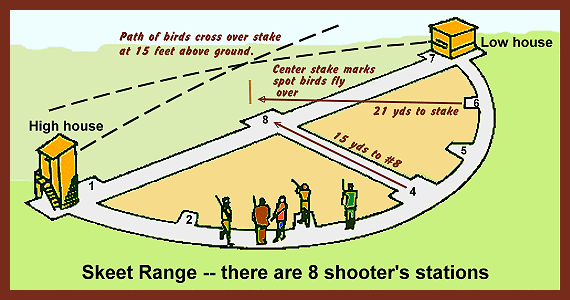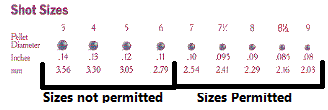
Disciplines
Centurion Gun Club offers the following clay target disciplines:
ATA Trap, DTL (Down the line), Olympic Double Trap, Olympic Trap, Universal Trench,
NSSA Skeet, Olympic Skeet, Sporting
Different types of Clay Target Shooting
Three types of Clay Target Shooting are shot in the Olympics: Olympic Trap, Double Trap and Skeet. The Olympic disciplines also have World Cups and World Championships.
There are many other disciplines which also take you to World Championship level – English Sporting, NSSA Skeet, DTL Trap, ATA Trap, FITASC Sporting, and FITASC Universal Trench. But whatever you want to do, whether it is simply having fun once or twice a month, or aiming to become a National Team Member, Clay Target Shooting is a vibrant, active sport at any level.

Trap
Included in this group are ATA Trap, DTL Trap, Double-Rise and ATA Trap Doubles. A single trap is located 16 yards in front of the line of shooters. There are 5 shooters in a squad and each shoot a single target in turn for both ATA Trap and DTL Trap. The main difference between the two is that only one cartridge may be loaded for ATA but both barrels can be used for DTL. The widest angle for the target also varies between the two disciplines. Maximum cartridge load for ATA is 32g and 28g for DTL. ATA Trap Doubles and Double-Rise are where two targets are launched off the same machine and the shooter must fire one shot at each target. All disciplines are shot over the same shooting range.

Trench
Included in this group are Olympic Trap, Universal Trench and Olympic Double-Trap. Olympic Trap uses 15 trap machines which are located in a trench in front of the shooters. Six shooters form a squad and shoot a single target in turn. The shooters stand in a line behind the trench. Targets are set in different ‘patterns’. Universal Trench uses the same shooting range as Olympic Trap, but only uses the middle 5 machines. Shooters shoot targets in rotation as per Olympic Trap. Patterns of targets are different. Olympic Double-Trap uses the same shooting range again and only uses the middle 3 traps. Two targets are launched simultaneously. The shooter must shoot one shot at each target.

Skeet
Included in this group are English Skeet, NSSA Skeet, Olympic Skeet and Olympic Skeet Doubles. The same range is used for all disciplines. The differences between them are variations of shooting sequences and speeds/distances of targets. Two trap ‘houses’ are located at opposite ends of a semi circle. Single targets are launched at which the shooter has only one shot. On some stands, two targets will be launched simultaneously (one target from each traphouse).

Sporting
Included in this group are English Sporting (Doubles), 5-Stand Sporting and FITASC Sporting. The main theme is the simulation of live field shooting. Targets must comply with strict range setting rules for safety and fairness. English Sporting is mainly set using combinations of ‘doubles’ – in other words, two targets (one shot at each target) where the shooter has one shot at each target. FITASC Sporting is more difficult in that there is a far greater variation of targets using both singles and doubles. 5-Stand Sporting uses Sporting targets but the group/squad of shooters stand in a line and shoot a target one after the other (unlike in the other two disciplines where only one shooter is on the shooting stand).
For purposes of clarity, we distinguish our disciplines into ‘standard’ and ‘sporting’. Standard being numbers 1 – 3 above because they are shot over fixed ranges with targets that are set according to very rigid rules on their trajectory and speed.

Shotguns
A variety of shotguns can be used for Clay target shooting. The most popular being the Over and Under which is a shotgun where one barrel sits on top of the other, joined together by “side ribs”. A Side-by-Side shotgun is where the barrels (two of them) sit side by side but it is not ideal for competitive Clay Target Shooting, but can be used for non-serious shooting or field shooting. The semi-Automatic Shotgun, this type of shotgun is ideal for someone who shoots a lot; for someone of a slight build or for a young person. The reason being is that it delivers very little recoil. It is a single-barreled shotgun where you can insert two cartridges in the breech. The recoil from the firing of the first cartridge loads the second cartridge. It is very important for the shooter to adhere to the safe carrying of this type of shotgun. The semi-auto should be carried with the barrel pointing upwards, breech open and facing forwards and the shotgun unloaded otherwise it can be safely carried unloaded in a normal gun bag.

Ammunition
The ammunition used to break the clay can be from a 12 guage to a .410. The cartridge contains a primer to ignite the shot powder which propels the lead shot out of the gun. Cartridges vary in their weight (in Clay Target Shooting we use from 24gm to 36gm) and in their shot size (from 2mm to 2.5mm diameter, no 7 - no 9) No larger shot sizes are permitted (no 6 and lower)


